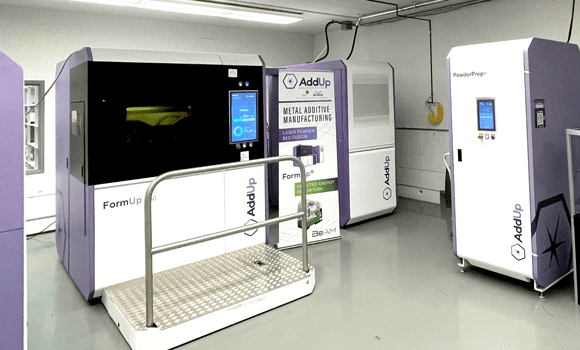AddUp, Inc, the American subsidiary of France’s AddUp SAS, and The Ohio State University have announced the installation of a FormUp 350 Laser Beam Powder Bed Fusion (PBF-LB) machine at Ohio State’s Center for Design and Manufacturing Excellence (CDME). The partnership is intended to offer students, researchers, and faculty expanded opportunities to develop Additive Manufacturing processes. It complements AddUp’s six FormUp 350 machines being installed at its own nearby Cincinnati, Ohio, facility.
“The FormUp 350 has already equipped us with capabilities which we do not have with our other printers,” stated Edward Herderick, the Director of Additive Manufacturing at CDME. “It has an open platform that allows us to tune strategies by accessing build parameters and enables us to achieve enhanced material properties through processing fine powder. We now can take on more complex projects requiring larger parts.”
“This machine provides the largest build plate of all our machines in the additive lab at the CDME, with the capacity to print 350 X 350 [mm]. Within its first few weeks of operation, the FormUp 350 has quickly established itself as a reliable, operator-friendly platform.”
CDME houses more than $5 million worth of AM equipment, including industrial machines capable of processing metals, polymers, composites, biomaterials, and ceramics. The FormUp 350 machine will enhance the centre’s metal AM capabilities, enabling engineers to deliver reproducible series of industrial parts at high productivity levels.
“AddUp was familiar with Ohio State’s CDME and their robust AM programme, so we were happy to partner with the facility to showcase the FormUp 350,” stated Ken Wright, president of AddUp, Inc. “The FormUp 350 features our latest technology. It prints faster, is more efficient, and was designed for operator safety. We are committed to innovation and leading the industry in PBF technology, so what better place to showcase that technology than in our own backyard at CDME. We are excited to play a part in developing the future talent of the Additive Manufacturing industry.”
CDME works with companies and researchers to translate new technologies into market-ready products. These projects give student employees hands-on experience integrating new technology while providing customers with the workforce advantage necessary to compete in the global marketplace. CDME works with companies across a variety of industries – including aerospace, automotive, medical, energy, and tooling, to provide design, engineering, prototyping, and product enhancement – utilising the AM laboratory. This partnership also offers an opportunity for AddUp to showcase its new technology to a new customer base through the university.
“We are excited to partner with Ohio State and the CDME to participate in the research for new material and process developments for 3D printing using the FormUp 350,” Wright added. “Both AddUp and CDME are members of America Makes, so this partnership provides an opportunity to collaborate on rapid innovation projects to further the research for Additive Manufacturing applications.”
AddUp designed the FormUp 350 to address issues commonly faced in industrial AM, including quality, productivity, operator safety, and scalability. With customers representing a wide range of sectors, the FormUp 350 has been engineered to meet the quality requirements of industries like aeronautics, space, defence, medical and motorsports.
“The FormUp 350 provides a unique powder rolling system that has helped us print complex part geometries while maintaining quality,” explained Ben DiMarco, Additive Manufacturing Technologist for the CDME. “More specifically, the quality of the surface finish is significant for our partners in the aerospace and medical industries.”
“The FormUp 350 offers a modular build platform, which means we can quickly and economically scale from small research projects to full-scale industrial applications. This is a strong benefit for customers,” DiMarco added. “The machine also offers an open interface that’s user-friendly. The software is easy to navigate and implement changes to the machine parameters. This feature is particularly valuable when training our student employees on the machine.”
Wright added, “The FormUp 350 stands out among other PBF machines because it provides the highest-quality parts while ensuring user safety. The FormUp meets part quality requirements in terms of mechanical properties, geometric properties (up to 0.1 mm dimensional accuracy), and material density (up to 99.99%). Also, operators can work in safety, having zero contact with the powder thanks to our Autonomous Power Module, powder storage, machine feeding, and unfused powder recovering and sieving.”


